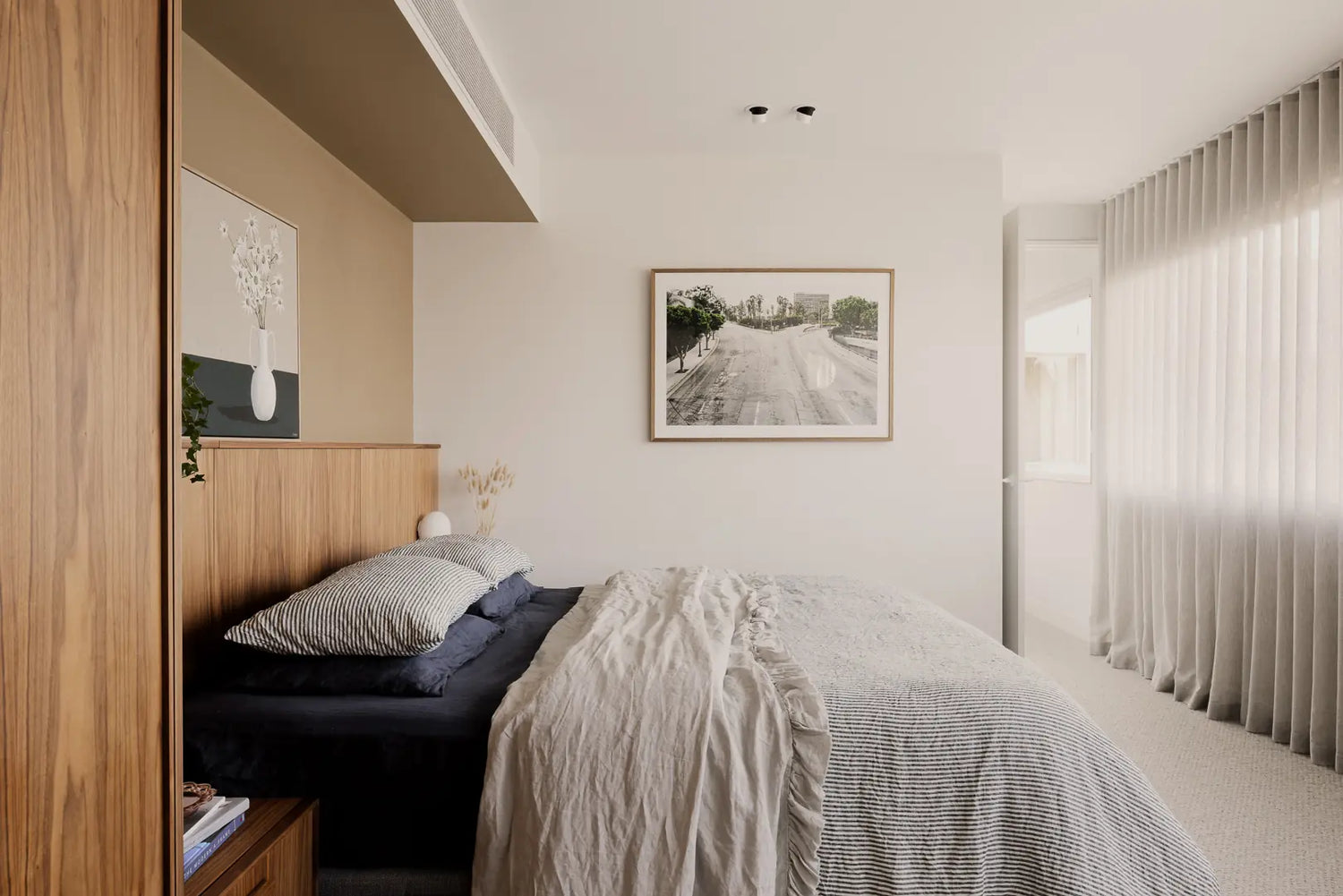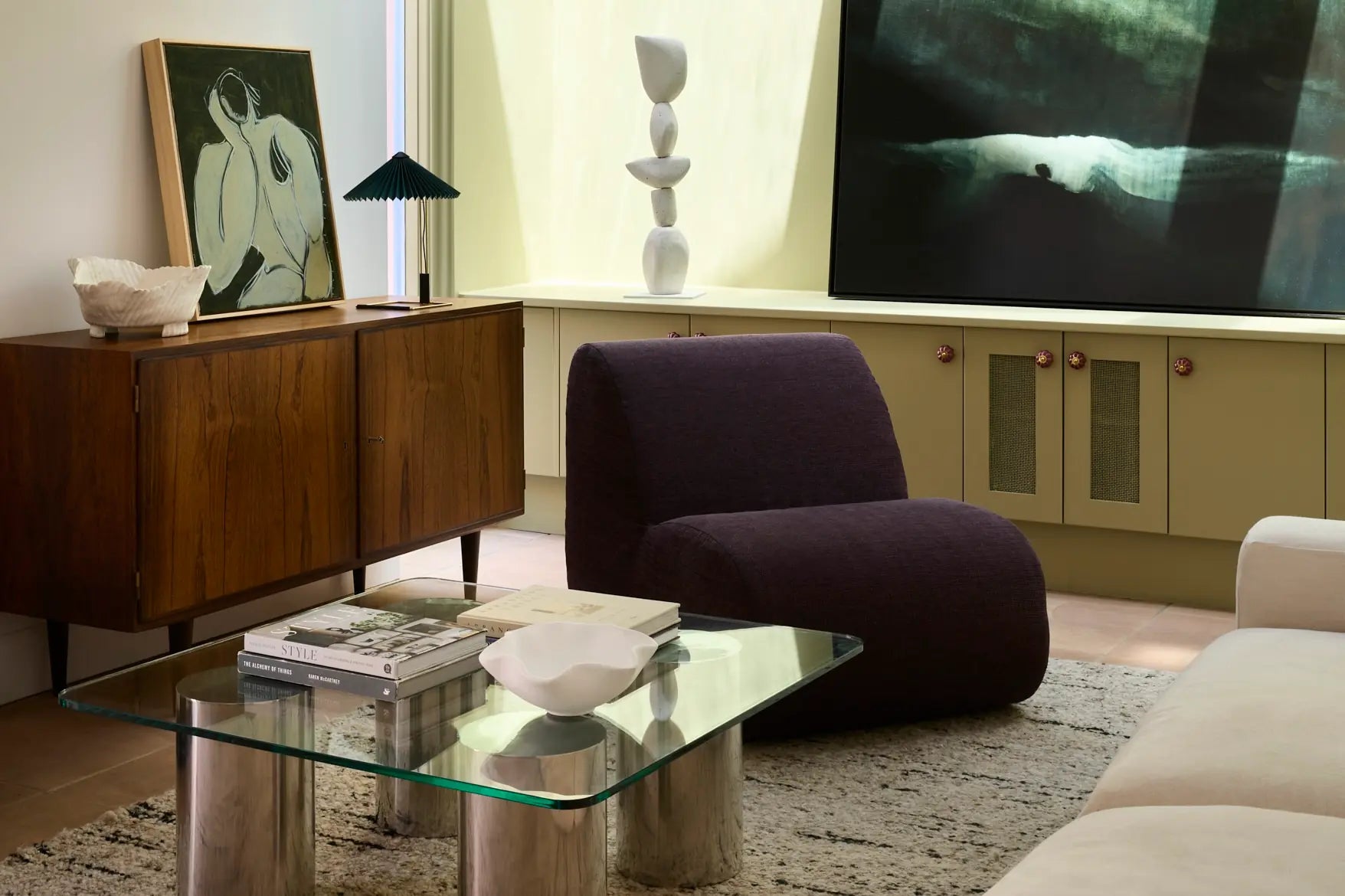Wall art. It was so much easier back in the days of the Smash Hits poster, wasn’t it? Tear it out, stick it up, and bingo – there was Jason Donavan in all his clean-cut golden-haired glory to adorn your bedroom wall. These days, now that we’re proper grown-ups, the art we hang in our homes is a little more sophisticated than a double-page spread with staple holes down the middle. It’s an expression of who we are, what we love, where we’ve been, and the style we covet. No pressure, right?
And it’s not even just about what we choose to display.
How we display it matters too. Even if you’re handy with a hammer and spirit level and know how to hang artwork, it’s not always as easy to know where to hang it and what height to hang it at, not to mention how big the piece should be.
It’s little wonder then, that wall art is often turfed into the too-hard basket when we’re decorating, and left for later.
Which, sometimes, is still coming years after we’ve settled into our homes.
But choosing and hanging wall art doesn’t have to be an ordeal.
The experts at FURNISHD. are here to help with some do’s and don’ts so that you can confidently use artwork to decorate your home.

Image courtesy of @faringsohuset
DO invest in art you love
It’s easy to be confused about the best way to choose art for your home, and one of the most common questions we get here at FURNISHD. is, quite simply, ‘How can I decorate my home with art?’
But there’s really only one thing to worry about when you’re buying art for your home.
It doesn’t matter if you’re investing in an original artwork, an inexpensive print, or you’re finally getting some photos framed and up on the wall – if you don’t love it as much as you loved that Jason Donovan poster in 1989, don’t buy it.
Simple as that. Your walls should be adorned with things that you really, truly love, and that make you feel happy and at home.
Well-chosen wall art will transform a room and give it some personality.
It’ll tell your story, personalise your home, and has the power to elevate a space from ‘nice’ to (as Kath would say) ‘noice’.

DON’T match your art to the decor
Does art have to match décor? Hell no!
Art is your chance to cut loose and break away from the colour scheme you’ve chosen for your interior, and it should look as though it’s been found and chosen organically, not like it’s been specifically shopped for to finish a room.
Similarly, art in contrasting styles to your décor can give a room extra edge and interest.
For example, a piece of modern abstract art hung in a traditionally furnished room can be a surprising winner.

Image courtesy of @gcgarchitectes
DON’T put art on every wall
Another question we get asked a lot is, ‘Should I put art on every wall?’
No-one’s stopping you, but ideally the answer to this one is no.
Blank walls help to make the arty ones pop, and also ensure that your art doesn’t end up feeling like vertical clutter.
Having some art-free walls also stops them from feeling as though they’re closing in on you, particularly in smaller rooms.
Choose the walls with the least number of interruptions, like windows and air conditioning units, and fill them with pieces you love.
DO consider painting the wall to make your art pop
It’s easy to go for white walls – they go with most interior styles and are fresh and space-making.
But even though white won’t necessarily compete for attention with your art, it also won’t bring out the best in it.
Just like those irritating baby sleep specialists like to tell us when we haven’t slept for more than an hour straight in a solid month that sleep begets sleep (excellent advice Jan, thanks), similarly, colour begets colour.
A coloured wall will bring out the detail in black and white photos and artwork, and enhance the hues and detail in coloured artwork also.
By painting a feature wall to display special pieces on, they’re really celebrated and featured.
If you’ve invested time and money in choosing art for your home, then it makes sense to also invest some thought into the colour of the wall you’ll hang it on.
So what is the best wall colour to display art?
Well, that depends on the pieces you’re hanging, but generally speaking strong colours make the most impact.
Choose a deep shade that suits your room, and that elevates the artwork.

Image courtesy of @fernsantini
DON’T worry too much about having matching frames
Should all frames in a room match?
They can, but don’t have to.
Match the frame to the piece first and foremost.
Hanging a collection of photos in matching frames makes them look like a unified statement piece, but only if they’re an exact match – slight mismatches stick out like an unmasked face at Coles during lockdown (and are just as exasperating), so sometimes it’s better just to choose contrasting (but complementary) frames right from the outset.
DO hang art in every room
DIY decorators often wonder where they should hang artwork.
Our take? Don’t be roomist when it comes to hanging art.
If there’s wall space, then there’s an opportunity to display something to elevate the room, whether it’s the dining room, kitchen, bathroom, or the ‘dad’ toilet that everyone else in the family is low-key terrified to enter.
What you do need to do though, is to consider each room’s unique environment when choosing pieces to ensure their longevity.
For example, if a wall space above a heater gets hot, choose a piece that will withstand the heat, or one that’s inexpensive enough to replace if it doesn’t hold up.
Or if your bathroom gets steamier than a scene from Fifty Shades, select a piece that won’t be too affected by the moisture in the air.
Art prints on canvas are ideal, as they generally have a protective coating – just stay away from anything behind glass, and definitely don’t hang spendy fine art, just in case.
"Consider each room’s unique environment when choosing pieces to ensure their longevity."
DO go big when choosing art
When it comes to wall art, size really does matter. So, how big should artwork be?
Pieces that are too small look stranded, and a few tiny pieces hung together can look more like clutter than a feature.
Scale is important when choosing art, and one large piece can often make a space seem bigger.
If you’re hanging a piece above a piece of large furniture, like a bed or couch, a good rule to follow is that the piece should be around 2/3 the width of the piece of furniture.
If you have a print or photo that you really love, but it’s too small to comply with this rule, you might be able to have it framed with a more generously sized matte or broader frame to increase its overall size and give it greater wall presence.
Alternatively, a gallery of several pieces can also be used to ‘frame’ furniture, but the same rule of size applies – just look at the collection as though it’s one piece and have it take up 2/3 of the width, as you would with one large piece.
Basically the rule here is to go big or go home.
Obviously you’re already at home because that’s where you’re trying to hang the art, but you get what we mean.
Just go big!

DO consider different ways to display your art
There are lots of ways to display art in your home.
You can hang it on the walls, lean it against them on top of furniture, or use shelves to house collections of artworks that you can rotate periodically.
You can use removable hooks if you’re renting or don’t want to hammer nails into your walls, or you can even install an old-school picture rail to hang art from hooks.

Image courtesy of @vladimirkagandesign
DO hang your art at the right height!
This is where things start to get a bit technical.
When it comes to successfully hanging art, the height it’s hung at is as crucial as deep breathing is to successfully navigating remote learning.
But what is the proper height to hang art?
There’s something really disconcerting about art that’s hung too high, so make sure that the centre point of the piece is at eye level.
If you’re hanging a group of pieces together, rather than just one single piece on its own, then the centre point of the group should be at eye level.
Obviously, because we’re all different heights, eye-level is technically different for everyone, so as a rule of thumb, if the centre point is around 144cm (57 inches) from the floor, you’re on the money.
The only time this rule can be comfortably broken, is if you’re hanging the piece above a piece of furniture, in which case it can look best if the piece is vertically centred from the highest point of the furniture to the ceiling, so the space between the furniture and the art is the same as the space between the art and the ceiling.

DO space pieces in a group correctly
If there’s too much of a gap between artworks they can look like they’re not playing nicely together to create one cohesive display.
Keep about two inches or less between pieces, and be consistent with the space that you leave between pieces on a gallery wall.
DO create visual balance by mixing up sizes
If you have a good selection of pieces ready to hang, don’t group and hang them by size.
Visual balance can be achieved by mindfully grouping smaller and larger pieces on a wall together.

DO centre artwork when hanging it above furniture
If you’re hanging a piece or a gallery wall above a piece of furniture like a couch or bed, it needs to be centred to the furniture, not the wall it’s hanging on. Or, it can also be ‘anchored’ to the piece of furniture, but placed off centre. Just don’t anchor it to the wall!
DO get a professional in to hang your art if you’re not confident or don’t have the time!
If you don’t know your way around a tool box, ask for help! Don’t leave that beautiful painting languishing under the spare bed. Get that beauty out and up on the wall!
If your walls are naked and screaming for some art, FURNISHD. can help! We have access to a huge number of premium suppliers and can source art to suit and taste and any space.



